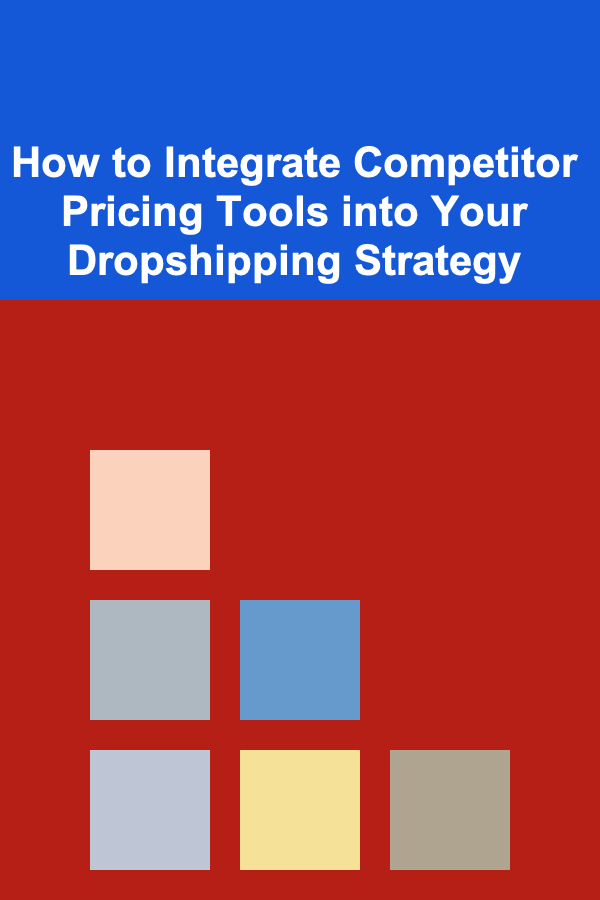
How to Integrate Competitor Pricing Tools into Your Dropshipping Strategy
ebook include PDF & Audio bundle (Micro Guide)
$12.99$8.99
Limited Time Offer! Order within the next:

In the world of dropshipping, staying competitive is key to your success. One of the most effective ways to maintain an edge over your competitors is by using competitor pricing tools. These tools enable you to monitor and analyze the prices of products sold by your competitors, giving you the insights you need to adjust your pricing strategy in real time. In this guide, we'll explore how to effectively integrate competitor pricing tools into your dropshipping business to improve profitability, enhance customer retention, and stay ahead of the competition.
Why Competitor Pricing Matters in Dropshipping
Before diving into the specifics of how to use pricing tools, let's understand why pricing is such a critical factor in dropshipping.
- Market Sensitivity: In dropshipping, where product fulfillment is handled by a third party, your business model is highly sensitive to price fluctuations. Prices need to be competitive to capture the attention of potential customers, especially in a crowded online marketplace.
- Profit Margins: Since you don't have control over manufacturing costs or inventory, the only way to affect profitability is through pricing. By adjusting your pricing based on competitors' rates, you can ensure your business remains profitable while offering customers attractive prices.
- Customer Perception: Customers are often looking for the best deal, and a competitive price point can be the deciding factor in a purchase decision. Tools that allow you to track and optimize your pricing can improve your conversion rates and overall customer satisfaction.
- Market Trends: Competitor pricing tools also provide insights into market trends. By analyzing how competitors are pricing, you can identify patterns in consumer behavior and adjust your strategy accordingly.
How Competitor Pricing Tools Work
Competitor pricing tools are software or services that allow you to monitor, track, and compare the prices of products sold by your competitors in real time. These tools use web scraping, API integrations, and artificial intelligence to gather data from online stores and marketplaces, giving you a comprehensive view of the pricing landscape.
Some key features of competitor pricing tools include:
- Price Monitoring: Tracks prices across different eCommerce platforms and updates you whenever there is a price change.
- Price Comparison: Compares your prices with your competitors and suggests adjustments.
- Price Alerts: Notifies you when a competitor reduces or increases their prices significantly.
- Market Insights: Offers analytical insights into how competitors' pricing strategies impact their sales and overall performance.
Steps to Integrate Competitor Pricing Tools into Your Dropshipping Strategy
1. Choose the Right Competitor Pricing Tool
The first step in integrating competitor pricing tools into your dropshipping strategy is selecting the right tool. With a variety of options available, it's important to choose one that aligns with your business goals, budget, and the types of products you sell. Here are some factors to consider when choosing a tool:
- Data Accuracy: Ensure the tool provides accurate, real-time data. Incorrect or outdated information could lead to mispricing your products.
- Ease of Use: The tool should have an intuitive interface that makes it easy to monitor and analyze competitor pricing data.
- Integration Capabilities: Check if the tool can integrate with your existing eCommerce platform (such as Shopify, WooCommerce, or BigCommerce) to automate pricing adjustments.
- Customer Support: Look for tools that offer solid customer support in case you run into issues.
Some popular competitor pricing tools for dropshipping businesses include:
- Prisync: A powerful competitor price tracking tool with automation features that works seamlessly with major eCommerce platforms.
- RepricerExpress: Allows for real-time price comparison and repricing across multiple channels.
- Price2Spy: Offers extensive features like competitor analysis, price monitoring, and customizable alerts.
2. Set Your Pricing Rules
Once you've selected a pricing tool, the next step is setting up your pricing rules. Pricing rules are parameters that determine how your prices should be adjusted based on competitor pricing data.
- Dynamic Pricing: Many dropshippers use dynamic pricing, where their product prices automatically adjust in response to competitors' pricing changes. With dynamic pricing, you can ensure that your prices stay competitive without manual intervention. For example, you could set a rule where your product price is always 5% lower than the competitor's price.
- Profit Margins: While staying competitive is important, you should also factor in your desired profit margins. Ensure that your pricing rules account for the cost of goods sold (COGS), shipping, transaction fees, and other expenses to maintain profitability.
- Pricing Floor and Ceiling: Set a minimum and maximum price threshold to avoid underpricing or overpricing. This will ensure that even in the most competitive market, your pricing remains sustainable.
3. Monitor Competitor Pricing Regularly
Competitor pricing is fluid, and prices can change frequently. To keep up with market trends, it's essential to regularly monitor your competitors' pricing data. Here's how you can do that effectively:
- Real-Time Alerts: Most competitor pricing tools offer alerts when a competitor changes their prices. Set up real-time notifications so you can quickly respond to any significant price shifts.
- Pricing Trends: Over time, analyze the pricing patterns of your competitors. Are they increasing prices during certain seasons or dropping them during sales events? This data can help you anticipate changes and strategize accordingly.
- Price Comparison Reports: Use the reporting features of your pricing tool to generate regular reports that highlight how your prices compare to competitors. This can provide actionable insights into whether your pricing strategy is working or needs adjustment.
4. Adjust Your Pricing Strategy Based on Data
After gathering and analyzing your competitor pricing data, it's time to make adjustments to your pricing strategy. Here are a few strategies you can implement:
- Undercutting Competitors: If you find a competitor is pricing their products higher than yours, consider lowering your price slightly to gain a competitive advantage. However, be cautious about lowering prices too much, as it may hurt your margins.
- Bundling Products: If your competitors are offering individual products at a higher price, you can create attractive product bundles to offer more value. Bundling can differentiate your store while still allowing you to remain competitive in terms of pricing.
- Promotions and Discounts: Use competitor pricing data to run targeted promotions. For example, if a competitor is running a sale, you could offer a limited-time discount to attract customers without having to lower your regular prices permanently.
- Geographic Pricing: In some cases, competitors may have different pricing in different regions or countries. Take advantage of this by adjusting your pricing strategy based on geographic location, ensuring you cater to specific markets with tailored offers.
5. Test and Refine Your Pricing Strategy
Once you've implemented changes based on competitor pricing data, it's important to track the results and test different pricing strategies. Dropshipping businesses often benefit from A/B testing, where you compare two versions of a product's price to see which one performs better.
- Conversion Rate Optimization: Test different price points to see how they impact conversion rates. If you find that a small price reduction leads to a noticeable increase in sales, consider making that adjustment across your product range.
- Customer Feedback: Pay attention to customer feedback regarding pricing. Are customers satisfied with the perceived value of your products? If they think your prices are too high, they may leave your store without completing the purchase.
- Competitor Shifts: Continually monitor your competitors to see how their pricing shifts over time. If your competitors change their pricing models, be prepared to respond and adjust your strategy accordingly.
6. Leverage Competitor Pricing for Long-Term Strategy
Competitor pricing tools are not just for short-term price adjustments. They can be a valuable resource for shaping your long-term pricing strategy.
- Competitive Positioning: By understanding how your competitors price their products, you can identify areas where you can position your store as the best option in terms of value, quality, or customer service.
- Branding and Perception: Pricing can play a significant role in shaping your brand image. Consider whether you want to position yourself as a budget-friendly option or a premium brand. Align your competitor pricing strategy with your brand's overall positioning.
- Market Penetration: Use competitor pricing tools to help you assess new markets or product categories. If your competitors are underpricing in a certain area, this could be an opportunity to enter that market with a competitive price point.
Conclusion
Integrating competitor pricing tools into your dropshipping strategy is an essential step toward staying competitive in today's fast-paced eCommerce landscape. By using these tools effectively, you can monitor competitors, adjust your pricing strategy, and optimize your profit margins. However, it's important to remember that pricing should not be the only factor in your strategy. Always consider customer value, your brand identity, and long-term market positioning to ensure sustained success.
Reading More From Our Other Websites
- [Personal Care Tips 101] How to Burn Fat with Kettlebell Exercises
- [Home Cleaning 101] How to Protect Your Home from Dust and Allergens
- [Paragliding Tip 101] Soaring Stories: The Best Paragliding Podcasts Featuring Interviews with World Record Holders
- [Gardening 101] Eco‑Friendly Glow: Sustainable Garden Lighting Solutions for Every Budget
- [Home Lighting 101] How to Create a Dramatic Effect with Track Lighting
- [Home Budget Decorating 101] How to Host Dinner Parties in Style with These Cheap Dining Room Ideas
- [Home Staging 101] How to Stage a Home with Bold, Vibrant Colors
- [Home Maintenance 101] How to Maintain Your Water Heater: A Comprehensive Guide
- [Home Budget Decorating 101] How to Choose Paint Colors That Won't Break the Bank
- [Survival Kit 101] Top 10 Prepping Gear Items Every Prepper Should Have

How to Build an Investment Portfolio on a Budget
Read More
How to Clean Your Refrigerator to Avoid Spoiled Food
Read More
How to Create a Productive Home Office Setup
Read More
How to Improve Website Security to Build User Trust
Read More
How to Renovate Your Home's Windows for Better Insulation
Read More
How to Schedule Regular Family Meetings for Open Communication
Read MoreOther Products

How to Build an Investment Portfolio on a Budget
Read More
How to Clean Your Refrigerator to Avoid Spoiled Food
Read More
How to Create a Productive Home Office Setup
Read More
How to Improve Website Security to Build User Trust
Read More
How to Renovate Your Home's Windows for Better Insulation
Read More